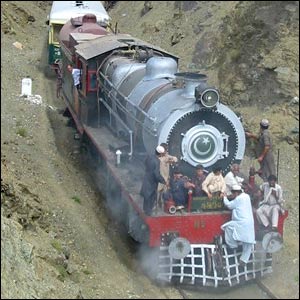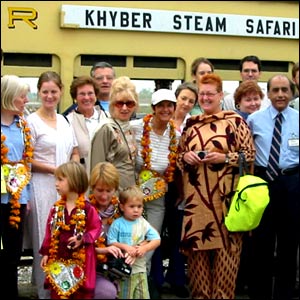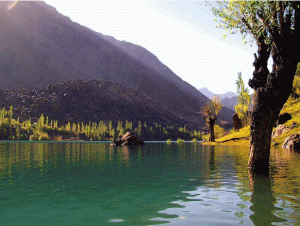British in view of the building threat from the Russians, laid a 42 kilometres long Khyber Railway track in 1920s from Peshawar to Landi Kotal at an enormous cost of Rupees 6 million. The train coaches are pulled and pushed by two 1920s vintage oil fired steam engines ( HGS 2-8-OS ) – one in the rear and one up front, to climb 1200 meters through 34 tunnels and 92 bridges and culverts. At one point the track climbs to 130 meters after a journey of 1.4 kilometres, by means of the famous Shagai Spur, a section of the track shaped like A  with two reversing stations. A section of the track is shaped like a W and the train has to move in changing directions. The tribes people travel free as part of the contract agreed upon when they allowed the British to build the railway through their territory and this rule is still honoured. As can be seen from the sketch above, the railway track twists over the Kyber Pass with gradients as steep as 1 in 33 near the summit at Landi Kotal. And the steam engine really has to pull hard to take the coaches atop the summit as seen below (below).
with two reversing stations. A section of the track is shaped like a W and the train has to move in changing directions. The tribes people travel free as part of the contract agreed upon when they allowed the British to build the railway through their territory and this rule is still honoured. As can be seen from the sketch above, the railway track twists over the Kyber Pass with gradients as steep as 1 in 33 near the summit at Landi Kotal. And the steam engine really has to pull hard to take the coaches atop the summit as seen below (below).
The North West Frontier Province of Pakistan abounds relics of history from time immemorial to invasion of the Alexander the Great, then a chain of Muslim warriors and finally the British in their quest to subjugate Afghanistan and make it part of their Indian empire. After three Afghan Wars and loss of countless natives and the British, they finally decided to leave Afghanistan and much of the tribal area of present day Pakistan at its own. The railway line from Peshawar to just short of Landi Kotal near Pak-Afghan border is the last remembrance of the British. A road or railroad journey on this avenue reminds one with those grim days in the form of small, medium and large size forts, and the logos of British army regiments on blind turnings.
Those interested in history could not have had access to this difficult terrain but for the road and the innovative “Khyber Steam Safari” that not only has attraction for tourists but historians all over the world to see the once bloody battle grounds. This site is all about the Steam Safari, which is one of the most historical and interesting train journeys in the world today.
To keep the interest of the tourists alive, on each stop, the tour operator arranges band displays (bandsmen wearing British Raj day uniforms), the traditional “Khattak Dance”, group photos and perhaps hands shake with poor children anxiously gathered to see people from another world.
The best time to travel in this train is usually between the end of summers till October. The train leaves Peshawar at 0730 hours in the morning and brings back its load by 1700 hours in the evening. The package includes round trip train ride, refreshments en’ route, picnic lunch at Landikotal, sightseeing tour to Michni Check Post near Torkham viewpoint for the Pak-Afghan Border and all necessary permissions for traveling in the Tribal Territory.
The initial site seeing from Peshawar railway station onwards may not be heartening since area around the railway track is used as dumping ground for rubbish because of its inactivity. However, as soon as the train leaves the urban surroundings, an aroma of fresh air and lush green landscape captivates the tourists. The first stop at Jamrud brings bagpipers in view. Thereafter the train takes the tourists to the famous “Khyber Rifles” officers’ mess. The mess is a living legend of famous 19 and 20th century paintings, photographs and relics.
And the journey continues for five hours till the train reaches Landi Kotal, the end point of railway network. Many more things happen in between – but wouldn’t you want to come to Pakistan and ride the Steam Safari to enjoy it and seeing yourself?
in between – but wouldn’t you want to come to Pakistan and ride the Steam Safari to enjoy it and seeing yourself?
For the Khyber Safari, the best time is during winters. Mellow sun shine, breath taking scenery, the rhythmic chugging of steam locomotive hauling a train up one of the steepest grades possible on 5′-6” track, all make journey an unforgettable experience. The hospitable Pushtoons in their traditional dresses and following their centuries old customs add to the flavor. For reservation of this train Divisional Superintendent, Pakistan Railways, Peshawar can be contacted on the telephone No. 091-9210687.
The Pakistan Railways and the private travel enterprise operated the KSS successfully till May 14, 2007. This last train had 15 ambassadors and high commissioners of European Union countries onboard, who enjoyed its journey through Khyber Agency. Ever since the KSS has not been in operation, a powerful flood has washed away its track at several places, as well as damaged several bridges that it used to cross on its way. Pakistan Railways authorities, unfortunately, have so far not been able to restore the damaged track. As of now, this dream safari is dysfunctional, which once attracted tourists from all over the world.
History of Khyber Pass Railway
British during their occupation of the Indian Subcontinent were always fearful of a Russian invasion of India through the famous Khyber (present day in NWFP) or Bolan (present day in Balochistan) Pass. Therefore the decided to construct a strategic railways in both of these passes to thwart any Russian invasion. In 1879, after the second Anglo-Afghan war (1878-1880) a reconnaissance survey was conducted to find the feasibility of laying railways through Khyber Pass. However, the construction could not commence till 1905 from a place called Kacha Garhi between Peshawar and Jamrud. By 1907 a tarck of 32 kilometers was laid. In the meantime, international situation changed and an alliance took place between Russia and Afghanistan, wherein the Russia agreed to consider Afghanistan out of its circle of influence countries. This made the British to consider Russia as no longer a threat and the work Khyber Pass Railway was suspended.
The third Anglo-Afghan war of May 1919 rejuvenated the Khyber Pass Railway project. Colonel Gordon Hearn was assigned to the work of surveying and recommending the best route through Khyber Pass. Until now all surveys recommended a meter gauge (1000 mm) track. Gordon Hearn proposed that broad-gauge (1676 mm) line to be laid through the pass. Construction restarted in 1920 and the section from Jamrud to Landi Kotal, opened on November 3, 1925. In early September 1925, several weeks before the railway was properly completed, the first piece of track was laid into Landi Kotal station, but the end spike was left out. Victor Bayley, the engineer entrusted with the construction of Khyber Railway had a 10 year old daughter called Missy Sahibâ drove it in with 3 hammer blows. Then Bayley and his wife blew the whistle and drove the shunting engine pushing assorted wagons and a brake van into the station.
On April 3, 1926 another portion of 8 km track was opened up to Landi Khana which fell just 3 km short of the actual frontier post of Torkham. On December 15, 1932 the Landi Kotal to Landi Khana section of railway was closed down at the insistence  of Afghan Government. The cost of building Khyber Pass railway was accounted as Rupees 485000 per kilometer in 1926. The Khyber Pass railway has a ruling gradient of 3 percent between Jamrud and Landi Kotal. There is a rise of nearly 2000 feet in 34 kilometers, and a drop of 872 feet in the next 8 kilometers to Landi Khana, where in many places the gradient stiffens to 1 in 25. There are 4 reversing stations, 34 tunnels with an aggregate length of more than 4 kilometers, 92 bridges and culverts, and 4 locomotive watering stations. And during the construction, three million cubic yards of materials mainly rock, were moved in the cuttings and embankments. Reversing stations are an important feature of Khyber Pass. Since it is not easy to bend a train here due to tight space, trains switch tracks and engines change their roles. The trailing engine becomes the lead and vice versa at the reversing stations. Besides reversing stations, track at numerous places is also provided with the runway train catch sidings. Due to axle load limitations, diesel engines cannot run on this track. Therefore Khyber Pass railway to date is served by steam locomotion only. The Khyber Railways is the last of the great railway constructions undertaken on the frontier during the British Raj. From 1947 onwards, Pakistan Railway continued a weekly passenger service through Khyber Pass. The service ran free of charge simply as a gesture to prove to the fiercely independent tribesmen that the line, in-spite of them, was open and the Pakistan Government was the boss. The regular service in Khyber Pass stopped in 1982 due to the lack of commercial patronage.
of Afghan Government. The cost of building Khyber Pass railway was accounted as Rupees 485000 per kilometer in 1926. The Khyber Pass railway has a ruling gradient of 3 percent between Jamrud and Landi Kotal. There is a rise of nearly 2000 feet in 34 kilometers, and a drop of 872 feet in the next 8 kilometers to Landi Khana, where in many places the gradient stiffens to 1 in 25. There are 4 reversing stations, 34 tunnels with an aggregate length of more than 4 kilometers, 92 bridges and culverts, and 4 locomotive watering stations. And during the construction, three million cubic yards of materials mainly rock, were moved in the cuttings and embankments. Reversing stations are an important feature of Khyber Pass. Since it is not easy to bend a train here due to tight space, trains switch tracks and engines change their roles. The trailing engine becomes the lead and vice versa at the reversing stations. Besides reversing stations, track at numerous places is also provided with the runway train catch sidings. Due to axle load limitations, diesel engines cannot run on this track. Therefore Khyber Pass railway to date is served by steam locomotion only. The Khyber Railways is the last of the great railway constructions undertaken on the frontier during the British Raj. From 1947 onwards, Pakistan Railway continued a weekly passenger service through Khyber Pass. The service ran free of charge simply as a gesture to prove to the fiercely independent tribesmen that the line, in-spite of them, was open and the Pakistan Government was the boss. The regular service in Khyber Pass stopped in 1982 due to the lack of commercial patronage.
